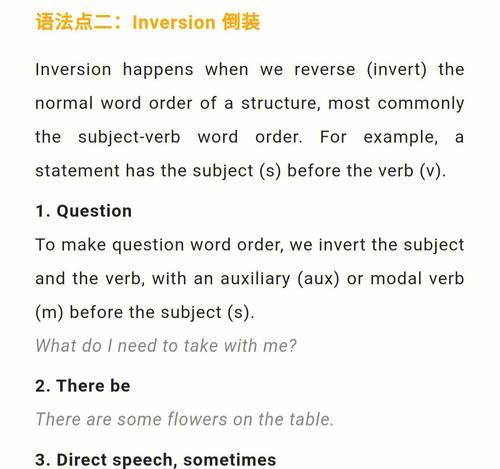英语倒装语法是将主语和谓语的位置颠倒,分为全部倒装、部分倒装和否定句倒装。全部倒装主要用于表语或状语开头的句子,以及“here”或“there”为主语的句子。部分倒装出现在否定的副词或短语后面的句子,以及表示“只有”“几乎没有”“很少有”等意思的句子中。否定句倒装则是在否定句中将助动词和主语的位置颠倒。虽然在日常交流中使用较少,但在学术论文、科技文献等中经常使用。

全部倒装
全部倒装主要是在以下两种情况下使用:
- 在表语或状语(通常是表示地点或方向的副词)开头的句子中,如:
- On the wall hung a picture.
- In front of the house stood a tall tree.
- 在以“here”或“there”为主语的句子中,如:
- Here comes the bus.
- There goes the bell.
部分倒装
部分倒装指的是在一些特殊的情况下,将助动词和主语的位置颠倒,如:
- 在表示否定的副词或短语后面的句子中,如:
- Never have I seen such a beautiful sunset.
- Seldom do they go to the cinema.
- 在表示“只有”“几乎没有”“很少有”等意思的句子中,如:
- Only when you have experienced can you understand.
- Hardly had he arrived when it began to rain.
否定句倒装
否定句倒装是指在否定句中将助动词和主语的位置颠倒,如:
- I didn't see him. → Didn't I see him?
- They haven't finished yet. → Haven't they finished yet?
